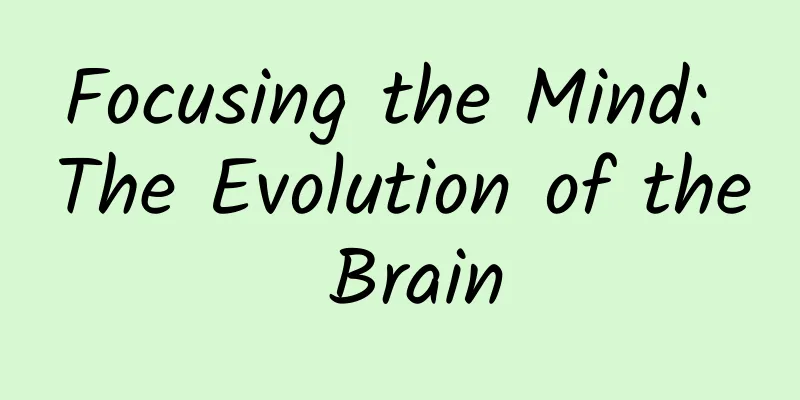Focusing the Mind: The Evolution of the Brain

|
The superior wisdom of the human brain has created a brilliant modern civilization. The most fundamental reason why humans surpass other creatures is the evolution of the brain, and the evolution of the brain also determines the present and future of humans. The brain has developed after a long process of biological evolution. The dominant force of evolution is natural selection, and the nervous system continues to develop and evolve through multiple genetic and mutation development processes. Santiago Ramón y Cajal, a famous neuroscientist and Nobel Prize winner in 1906, once said: "As long as the secrets of the brain are not revealed to the world, the universe will remain a mystery." The human brain contains about 86 billion neurons, which is more than ten times the world's population. Such a large number of specialized cell groups constitute the "CPU" of the human body, receiving external stimuli and also feeding back our emotional cognition. Neurons transmit information through their specialized structures-synaptic connections. The brain contains about one trillion synaptic connections, forming a complex neural network. The frontal lobe, parietal lobe, occipital lobe and temporal lobe are important "components" that make up the brain. The frontal lobe is responsible for advanced cognitive functions, such as thinking, planning, decision-making and emotional regulation; the parietal lobe is responsible for the integration of body perception, vision and spatial information; the temporal lobe is mainly responsible for language function and auditory perception, and participates in long-term memory and emotion; the occipital lobe is mainly responsible for visual perception and processing. These "components" constitute the central controller of the human body. The human cerebral cortex accounts for about 80% of the total mass of the brain. So, how did the brain evolve? Archaeological studies have shown that humans evolved from Australopithecus, which lived in Africa about 3.8 million to 2.1 million years ago. Australopithecus was about 1.2 meters tall, weighed about 30 kilograms, and had a brain capacity of about 500 milliliters. Australopithecus had some features similar to apes, such as flexible arms and long tails. However, they also had some features similar to humans, such as walking upright. About 2.5 million years ago, due to changes in climate and environment, only a few Australopithecus evolved into Homo habilis. Homo habilis had a much larger brain than Australopithecus, averaging 650-800 milliliters, and was the first primitive human to prepare and use tools (including stones, bones, and wood, etc.). At the same time, Homo habilis lived in small groups with relatively complex social relationships and could communicate with each other through simple language. About 2 million years ago, Homo habilis evolved into Homo erectus. Homo erectus had a brain capacity of about 1000 ml, used relatively complex language and stone tools, could control and use fire, and the first great migration of ancient humans from Africa to Europe and Asia occurred. Neanderthals are descendants of Homo erectus. Neanderthals are the "predecessors" with the fastest brain capacity evolution, with a brain capacity of about 1500 ml, used complex logical language, created more complex tools, and became more robust. In order to better adapt to the environment and obtain more food, Neanderthals began the second great migration, with footprints all over the world. The brain capacity of modern people is about 1600 ml, which is almost three times that of Australopithecus. In evolution, human ancestors freed their hands to perform more complex and delicate movements to adapt to the environment, and thus obtained an increase in brain capacity. Since humans first picked up stones and sticks and used fire, brain capacity has also increased exponentially in the process of adapting to the environment, creating important conditions for the emergence of higher intelligence. Therefore, the essence of human evolution is the evolution of the brain! Along with the rapid expansion of the cerebral cortex, the folding of the cortex is another milestone in the evolution of the mammalian brain. The folding of the cortex allows more cerebral cortex to be accommodated in the limited cranial cavity, and is the structural basis for advanced brain functions such as logic, thinking, cognition, emotion, fine motor skills, language, and consciousness. At the same time, the highly differentiated cortical sulci and gyri define various functional areas of the cerebral cortex. From the earliest Australopithecus to modern humans, the sulci and gyri of the brain have gradually evolved in a more refined direction. Although the degree of folding of the cerebral cortex is highly correlated with the level of intelligence, the sulci and gyri structure is not unique to primates. In fact, the three main branches of mammals—monotremes, marsupials, and placentals—all have species with no gyrus (smooth brains, such as rodents such as mice) and gyri. Therefore, the sulci and gyri structure of the cerebral cortex is likely to have evolved independently in the three branches of mammals. At the same time, the sulci and gyri structure of the brain is significantly conserved and different during evolution. According to its conservation and diversity, the cerebral cortex can be divided into three levels of sulci and gyrus: the primary sulci and gyrus are conserved among all species; the secondary sulci and gyrus are conserved within the same species but differ between different species; and the tertiary sulci and gyrus are differing between individuals within a species. Therefore, the huge expansion of the cerebral cortex to form a complex sulci and gyrus structure is one of the most significant changes in the evolution of the mammalian brain. The human brain has been evolving, but will it continue to evolve forever? Will humans become smarter? Some scholars believe that the brain can continue to evolve, and as it evolves, the brain capacity will gradually expand, and related genes will also evolve, making humans smarter. Another group of scholars believe that the brain cannot continue to evolve, mainly due to environmental and energy constraints. The weight of the human brain is only ~2% of the body weight, but it consumes ~25% of the body's energy: 500 kCal/day. That is to say, almost a quarter of the body's energy is supplied to the brain, which is much more than any other human organ. If the brain capacity is larger, more energy is required, which is obviously not suitable for the survival of the body. Studies have found that the structure and capacity of our brain are almost the same as tens of thousands of years ago, which may be related to the energy of the human body. The current energy of the human body can only maintain the current brain size, but the neurons and neural networks inside the brain have been developing in a more detailed way, and thinking ability, creativity, and imagination have also gradually improved, so people are getting smarter. Moreover, with the increasing diversity of hunting and cooking tools, humans can more easily obtain more energy, and human intelligence in the future may reach a height that we can't imagine. The emergence of the brain has enabled organisms to have the ability to adapt to the environment after birth, and also enabled organisms to have perception, language, emotion, cognition and other functions. Understanding, studying and exploring more potential possibilities of the brain is a matter of concern to mankind and a topic that requires long-term research in the future. Author: Cao Jingli, Institute of Brain Science, Fudan University Reviewer: Yu Yongchun Fudan University |
>>: 8000 degrees Celsius in space, a planet hotter than the sun!
Recommend
After ten years of hard work, BYD's Han, the world's safest, smart, and new energy flagship sedan, is now available
The arrival of Han will not only shake up the glo...
Tik Tok operation and promotion: 3 steps to create a hit product!
On June 12, 2018, the short video app Douyin anno...
Webb telescope: The mind-boggling details of its $10 billion construction
Seeing the first batch of color photos released b...
How to publish products on Baidu AiPurchasing? Baidu Ai Purchasing Information Release Operation Steps [Graphic and Text Detailed Explanation]
Baidu Ai Procurement information release operation...
How does a paid content store increase new users?
Since 2016, the concept of "micro-course&quo...
Are there "traps" on your computer desk? Beware of "mouse hand"!
1. What is “mouse hand”? "Mouse hand", ...
How to attract fans on Douyin? How does Tik Tok attract fans?
If there are not enough fans on the Douyin platfo...
How can enterprises promote themselves well?
How can enterprises do a good job of promoting th...
What is the gap between VR psychotherapy in Asia and Europe and the United States?
In recent days, a news report about "a forei...
If a child has normal IQ but cannot read the words in a book, he may be suffering from "dyslexia"
They have normal vision and normal minds, but the...
Qvod has not paid the 260 million yuan fine: the late payment fee is nearly 40 million yuan
After the high-priced fine of Qvod was issued on J...
Spring is here, and Cold Food Festival is here again: What you don’t know about Cold Food Festival
"Spring City has flying flowers everywhere, ...
How much does it cost to customize a supplement mini program in Jining?
The launch of mini programs has brought convenien...
A well-known writer died suddenly of a myocardial infarction. For myocardial infarction treatment, remember 120!
According to a message posted on Xinjiang Weibo, ...
Tong Yao was surrounded by a man at the elevator entrance asking for a hug. It is suspected that he was the man who proposed to harass Dilraba Dilmurat
[Tong Yao was surrounded by men at the elevator e...









